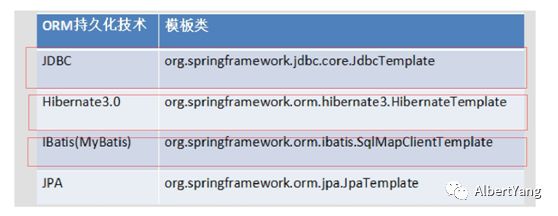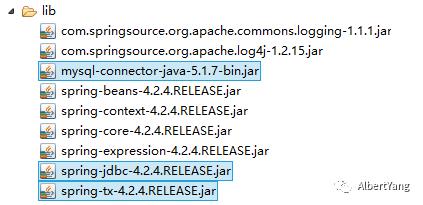Spring第三天:Spring的AOP的注解开发Spring的声明式事务JdbcTemplate
Posted AlbertYang
tags:
篇首语:本文由小常识网(cha138.com)小编为大家整理,主要介绍了Spring第三天:Spring的AOP的注解开发Spring的声明式事务JdbcTemplate相关的知识,希望对你有一定的参考价值。
1.Spring的AOP基于AspectJ的注解开发
1.1Spring基于ApsectJ的注解的AOP开发
1.1.1创建项目,引入jar包
1.1.2引入配置文件
1.1.3编写目标类并配置
目标类:
packagecom.albertyy.demo1;
/**
*
* 项目名称:SpringDay03_AOP
* 类名称:OrderDao
* 类描述:
* 创建人:yangyangyang
* 创建时间:2018年12月7日 下午2:58:44
* 修改人:yangyangyang
* 修改时间:2018年12月7日 下午2:58:44
* 修改备注:
* @version
*
*/
publicclass OrderDao{
publicvoid save(){
System.out.println("保存订单...");
}
publicvoid update(){
System.out.println("修改订单...");
}
public Stringdelete(){
System.out.println("删除订单...");
return"李君莫";
}
publicvoid find(){
System.out.println("查询订单...");
// intd = 1/0;
}
}
在配置文件配置中配置目标类:
<!-- 配置目标类 -->
<bean id="orderDao" class="com.albertyy.demo1.OrderDao">
</bean>
1.1.4编写切面类并配置
public class MyAspectAnno{
public void before(){
System.out.println("前置增强.....");
}
}
<!-- 配置切面类-->
<bean id="myAspect" class="com.albertyy.demo1.MyAspectAnno">
</bean>
1.1.5使用注解的AOP对象目标类进行增强
l 在配置文件中打开注解的AOP开发
<!-- 在配置文件中开启注解的AOP的开发 -->
<aop:aspectj-autoproxy/>
l 在切面类上使用注解
/**
*
* 项目名称:SpringDay03_AOP
* 类名称:MyAspectAnno
* 类描述:注解的切面类
* 创建人:yangyangyang
* 创建时间:2018年12月7日 下午3:00:55
* 修改人:yangyangyang
* 修改时间:2018年12月7日 下午3:00:55
* 修改备注:
* @version
*
*/
@Aspect
publicclassMyAspectAnno {
@Before(value="execution(*com.albertyy.demo1.OrderDao.save(..))")
publicvoid before(){
System.out.println("前置增强.....");
}
}
1.1.6编写测试类
packagecom.albertyy.demo1;
importjavax.annotation.Resource;
import org.junit.Test;
importorg.junit.runner.RunWith;
importorg.springframework.test.context.ContextConfiguration;
importorg.springframework.test.context.junit4.SpringJUnit4ClassRunner;
/**
*
* 项目名称:SpringDay03_AOP
* 类名称:SpringDemo1
* 类描述:Spring的AOP的注解开发
* 创建人:yangyangyang
* 创建时间:2018年12月7日 下午2:59:42
* 修改人:yangyangyang
* 修改时间:2018年12月7日 下午2:59:42
* 修改备注:
*@version
*
*/
@RunWith(SpringJUnit4ClassRunner.class)
@ContextConfiguration("classpath:applicationContext.xml")
public class SpringDemo1 {
@Resource(name="orderDao")
private OrderDao orderDao;
@Test
public void demo1(){
orderDao.save();
orderDao.update();
orderDao.delete();
orderDao.find();
}
}
1.2Spring的注解的AOP的通知类型
1.2.1@Before :前置通知
@Before(value="execution(*com.albertyy.demo1.OrderDao.save(..))")
publicvoid before(){
System.out.println("前置增强.....");
}
1.2.2@AfterReturning :后置通知
// 后置通知:
@AfterReturning(value="execution(*com.albertyy.demo1.OrderDao.delete(..))",returning="result")
publicvoidafterReturning(Object result){
System.out.println("后置增强....."+result);
}
1.2.3@Around :环绕通知
// 环绕通知:
@Around(value="execution(*com.albertyy.demo1.OrderDao.update(..))")
public Objectaround(ProceedingJoinPoint joinPoint) throwsThrowable{
System.out.println("环绕前增强.....");
Objectobj = joinPoint.proceed();
System.out.println("环绕后增强.....");
returnobj;
}
1.2.4@AfterThrowing :异常抛出通知
// 异常抛出通知:
@AfterThrowing(value="execution(*com.albertyy.demo1.OrderDao.find(..))",throwing="e")
publicvoidafterThrowing(Throwable e){
System.out.println("异常抛出增强....."+e.getMessage());
}
1.2.5@After :最终通知
// 最终通知
@After(value="execution(*com.albertyy.demo1.OrderDao.find(..))")
publicvoid after(){
System.out.println("最终增强.......");
}
1.3Spring的注解的AOP的切入点的配置
packagecom.albertyy.demo1;
importorg.aspectj.lang.ProceedingJoinPoint;
importorg.aspectj.lang.annotation.After;
importorg.aspectj.lang.annotation.AfterReturning;
importorg.aspectj.lang.annotation.AfterThrowing;
importorg.aspectj.lang.annotation.Around;
importorg.aspectj.lang.annotation.Aspect;
importorg.aspectj.lang.annotation.Before;
importorg.aspectj.lang.annotation.Pointcut;
/**
*
* 项目名称:SpringDay03_AOP
* 类名称:MyAspectAnno
* 类描述:注解的切面类
* 创建人:yangyangyang
* 创建时间:2018年12月7日 下午3:00:55
* 修改人:yangyangyang
* 修改时间:2018年12月7日 下午3:00:55
* 修改备注:
* @version
*
*/
@Aspect
publicclassMyAspectAnno {
@Before(value="MyAspectAnno.pointcut2()")
publicvoid before(){
System.out.println("前置增强.....");
}
// 后置通知:
@AfterReturning(value="MyAspectAnno.pointcut4()",returning="result")
publicvoidafterReturning(Object result){
System.out.println("后置增强....."+result);
}
// 环绕通知:
@Around(value="MyAspectAnno.pointcut3()")
public Objectaround(ProceedingJoinPoint joinPoint) throwsThrowable{
System.out.println("环绕前增强.....");
Objectobj = joinPoint.proceed();
System.out.println("环绕后增强.....");
returnobj;
}
// 异常抛出通知:
@AfterThrowing(value="MyAspectAnno.pointcut1()",throwing="e")
publicvoidafterThrowing(Throwable e){
System.out.println("异常抛出增强....."+e.getMessage());
}
// 最终通知
@After(value="MyAspectAnno.pointcut1()")
publicvoid after(){
System.out.println("最终增强.......");
}
// 切入点注解:
@Pointcut(value="execution(*com.albertyy.demo1.OrderDao.find(..))")
privatevoidpointcut1(){}
@Pointcut(value="execution(*com.albertyy.demo1.OrderDao.save(..))")
privatevoidpointcut2(){}
@Pointcut(value="execution(*com.albertyy.demo1.OrderDao.update(..))")
privatevoidpointcut3(){}
@Pointcut(value="execution(*com.albertyy.demo1.OrderDao.delete(..))")
privatevoidpointcut4(){}
}
2.Spring的JDBC的模板的使用

2.1Spring的JDBC的模板
Spring是EE开发的一站式的框架,有EE开发的每层的解决方案。Spring对持久层也提供了解决方案:ORM模块和JDBC的模板。
Spring提供了很多的模板用于简化开发:
2.1.1JDBC模板使用的入门
l 创建项目,引入jar包
n 引入基本开发包:
n 数据库驱动
n Spring的JDBC模板的jar包

2.1.2创建数据库和表
create database spring4_day03;
use spring4_day03;
create table account(
id intprimary key auto_increment,
namevarchar(20),
moneydouble
);
2.1.3使用JDBC的模板:保存数据
packagecom.albertyy.jdbc.demo1;
importorg.junit.Test;
importorg.springframework.jdbc.core.JdbcTemplate;
importorg.springframework.jdbc.datasource.DriverManagerDataSource;
/**
*
* 项目名称:SpringDay03_JDBC
* 类名称:JdbcDemo1
* 类描述:JDBC模板的使用
* 创建人:yangyangyang
* 创建时间:2018年12月7日 下午4:13:47
* 修改人:yangyangyang
* 修改时间:2018年12月7日 下午4:13:47
* 修改备注:
* @version
*
*/
publicclass JdbcDemo1{
@Test
// jdbc模板的使用类似于Dbutils.
publicvoid demo1(){
// 创建连接池:
DriverManagerDataSourcedataSource = newDriverManagerDataSource();
dataSource.setDriverClassName("com.mysql.jdbc.Driver");
dataSource.setUrl("jdbc:mysql:///spring4_day03");
dataSource.setUsername("root");
dataSource.setPassword("123456");
// 创建jdbc模板
JdbcTemplatejdbcTemplate = newJdbcTemplate();
jdbcTemplate.setDataSource(dataSource);
jdbcTemplate.update("insertinto account values (null,?,?)", "君陌",10000d);
}
}
2.2将连接池和模板交给Spring管理
2.2.1引入Spring的配置文件
<?xml version="1.0" encoding="UTF-8"?>
<beans xmlns="http://www.springframework.org/schema/beans"
xmlns:xsi="http://www.w3.org/2001/XMLSchema-instance"
xmlns:context="http://www.springframework.org/schema/context"
xmlns:aop="http://www.springframework.org/schema/aop"
xmlns:tx="http://www.springframework.org/schema/tx"
xsi:schemaLocation="http://www.springframework.org/schema/beans
http://www.springframework.org/schema/beans/spring-beans.xsd
http://www.springframework.org/schema/context
http://www.springframework.org/schema/context/spring-context.xsd
http://www.springframework.org/schema/aop
http://www.springframework.org/schema/aop/spring-aop.xsd
http://www.springframework.org/schema/tx
http://www.springframework.org/schema/tx/spring-tx.xsd">
<!-- 配置Spring的内置的连接池======================== -->
<bean id="dataSource" class="org.springframework.jdbc.datasource.DriverManagerDataSource">
<property name="driverClassName" value="com.mysql.jdbc.Driver"/>
<property name="url" value="jdbc:mysql:///spring4_day03"/>
<property name="username" value="root"/>
<property name="password" value="123456"/>
</bean>
<!-- 配置Spring的JDBC的模板=========================-->
<bean id="jdbcTemplate" class="org.springframework.jdbc.core.JdbcTemplate">
<property name="dataSource" ref="dataSource" />
</bean>
</beans>
2.2.2使用Jdbc的模板
l 引入spring_aop的jar包
packagecom.albertyy.jdbc.demo1;
importjavax.annotation.Resource;
importorg.junit.Test;
importorg.junit.runner.RunWith;
importorg.springframework.jdbc.core.JdbcTemplate;
importorg.springframework.test.context.ContextConfiguration;
importorg.springframework.test.context.junit4.SpringJUnit4ClassRunner;
/**
*
* 项目名称:SpringDay03_JDBC
* 类名称:JdbcDemo2
* 类描述: 将连接池和模板交给Spring管理
* 创建人:yangyangyang
* 创建时间:2018年12月7日 下午4:35:27
* 修改人:yangyangyang
* 修改时间:2018年12月7日 下午4:35:27
* 修改备注:
* @version
*
*/
@RunWith(SpringJUnit4ClassRunner.class)
@ContextConfiguration("classpath:applicationContext.xml")
publicclass JdbcDemo2{
@Resource(name="jdbcTemplate")
privateJdbcTemplate jdbcTemplate;
@Test
// 保存操作
publicvoid demo1(){
jdbcTemplate.update("insertinto account values (null,?,?)", "张小花儿",10000d);
}
}
2.3使用开源的数据库连接池:
2.3.1DBCP的使用
l 引入jar包
l 配置DBCP连接池
<!-- 配置DBCP连接池=============================== -->
<bean id="dataSource" class="org.apache.commons.dbcp.BasicDataSource">
<property name="driverClassName" value="com.mysql.jdbc.Driver"/>
<property name="url" value="jdbc:mysql:///spring4_day03"/>
<property name="username" value="root"/>
<property name="password" value="123456"/>
</bean>
<!-- 配置Spring的JDBC的模板=========================-->
<bean id="jdbcTemplate" class="org.springframework.jdbc.core.JdbcTemplate">
<property name="dataSource" ref="dataSource" />
</bean>
2.3.2C3P0的使用
l 引入c3p0连接池jar包
l 配置c3p0连接池
<!-- 配置C3P0连接池=============================== -->
<bean id="dataSource" class="com.mchange.v2.c3p0.ComboPooledDataSource">
<property name="driverClass" value="com.mysql.jdbc.Driver"/>
<property name="jdbcUrl" value="jdbc:mysql:///spring4_day03"/>
<property name="user" value="root"/>
<property name="password" value="123456"/>
</bean>
<!-- 配置Spring的JDBC的模板=========================-->
<bean id="jdbcTemplate" class="org.springframework.jdbc.core.JdbcTemplate">
<property name="dataSource" ref="dataSource" />
</bean>
2.4抽取配置到属性文件
2.4.1定义一个属性文件jdbc.properties
jdbc.driverClass=com.mysql.jdbc.Driver
jdbc.url=jdbc:mysql:///spring4_day03
jdbc.username=root
jdbc.password=123456
2.4.2在Spring的配置文件中引入属性文件
l 第一种:
<!-- 第一种方式通过一个bean标签引入的(很少用) -->
<bean class="org.springframework.beans.factory.config.PropertyPlaceholderConfigurer">
<property name="location" value="classpath:jdbc.properties"/>
</bean>
l 第二种:
<!-- 第二种方式通过context标签引入的 -->
<context:property-placeholder location="classpath:jdbc.properties"/>
2.4.3引入属性文件的值
<!-- 配置C3P0连接池=============================== -->
<bean id="dataSource" class="com.mchange.v2.c3p0.ComboPooledDataSource">
<property name="driverClass" value="${jdbc.driverClass}"/>
<property name="jdbcUrl" value="${jdbc.url}"/>
<property name="user" value="${jdbc.username}"/>
<property name="password" value="${jdbc.password}"/>
</bean>
2.4.4测试
@Test
// 保存操作
publicvoid demo1(){
jdbcTemplate.update("insertinto account values (null,?,?)", "十三先生",10000d);
}
2.5使用JDBC的模板完成CRUD的操作
2.5.1保存操作
@Test
// 保存操作
publicvoid demo1(){
jdbcTemplate.update("insertinto account values (null,?,?)", "陈皮皮",10000d);
}
2.5.2修改操作
@Test
// 修改操作
publicvoid demo2(){
jdbcTemplate.update("updateaccount set name = ? ,money = ? where id = ?", "叶红鱼",2000d,1);
}
2.5.3删除操作
@Test
// 删除操作
publicvoid demo3(){
jdbcTemplate.update("deletefrom account where id = ?", 6);
}
2.5.4查询操作
l 查询某个属性
@Test
// 查询操作:
publicvoid demo4(){
Stringname = jdbcTemplate.queryForObject("selectname from account where id = ?", String.class, 5);
System.out.println(name);
}
@Test
// 统计查询
publicvoid demo5(){
Longcount = jdbcTemplate.queryForObject("selectcount(*) from account", Long.class);
System.out.println(count);
}
l 查询返回对象或集合
@Test
// 封装到一个对象中
publicvoid demo6(){
Accountaccount = jdbcTemplate.queryForObject("select* from account where id = ?", newMyRowMapper(), 5);
System.out.println(account);
}
@Test
// 查询多条记录
publicvoid demo7(){
List<Account>list = jdbcTemplate.query("select* from account", newMyRowMapper());
for (Account account : list) {
System.out.println(account);
}
}
l 数据封装
classMyRowMapper implementsRowMapper<Account>{
@Override
public AccountmapRow(ResultSet rs, introwNum) throwsSQLException {
Accountaccount = newAccount();
account.setId(rs.getInt("id"));
account.setName(rs.getString("name"));
account.setMoney(rs.getDouble("money"));
returnaccount;
}
}
3.Spring的事务管理
3.1事务的基本概念
3.1.1什么事务
l 事务:逻辑上的一组操作,组成这组操作的各个单元,要么全都成功,要么全都失败。
3.1.2事务的特性
l 原子性:事务不可分割.
l 一致性:事务执行前后数据完整性保持一致。
l 隔离性:一个事务的执行不应该受到其他事务的干扰。
l 持久性:一旦事务结束,数据就持久化到数据库。
3.1.3如果不考虑隔离性引发安全性问题
l 读问题
n 脏读 :一个事务读到另一个事务未提交的数据
n 不可重复读 :一个事务读到另一个事务已经提交的update的数据,导致一个事务中多次查询结果不一致
n 虚读、幻读 :一个事务读到另一个事务已经提交的insert的数据,导致一个事务中多次查询结果不一致。
l 写问题
n 丢失更新
3.1.4解决读问题
l 设置事务的隔离级别
n Read uncommitted :未提交读,任何读问题都解决不了。
n Read committed :已提交读,解决脏读,但是不可重复读和虚读有可能发生。
n Repeatable read :重复读,解决脏读和不可重复读,但是虚读有可能发生。
n Serializable :解决所有读问题。
3.2Spring的事务管理的API
3.2.1PlatformTransactionManager:平台事务管理器
l 平台事务管理器:接口,是Spring用于管理事务的真正的对象。
n DataSourceTransactionManager :底层使用JDBC管理事务
n HibernateTransactionManager :底层使用Hibernate管理事务
3.2.2TransactionDefinition :事务定义信息
l 事务定义:用于定义事务的相关的信息,隔离级别、超时信息、传播行为、是否只读
3.2.3TransactionStatus:事务的状态
l 事务状态:用于记录在事务管理过程中,事务的状态的对象。
3.2.4事务管理的API的关系:
Spring进行事务管理的时候,首先平台事务管理器根据事务定义信息进行事务的管理,在事务管理过程中,产生各种状态,将这些状态的信息记录到事务状态的对象中。
3.3Spring的事务的传播行为
l Spring中提供了七种事务的传播行为:
n 保证多个操作在同一个事务中
u PROPAGATION_REQUIRED :默认值,如果A中有事务,使用A中的事务,如果A没有,创建一个新的事务,将操作包含进来。
u PROPAGATION_SUPPORTS :支持事务,如果A中有事务,使用A中的事务。如果A没有事务,不使用事务。
u PROPAGATION_MANDATORY :如果A中有事务,使用A中的事务。如果A没有事务,抛出异常。
n 保证多个操作不在同一个事务中
u PROPAGATION_REQUIRES_NEW :如果A中有事务,将A的事务挂起(暂停),创建新事务,只包含自身操作。如果A中没有事务,创建一个新事务,包含自身操作。
u PROPAGATION_NOT_SUPPORTED :如果A中有事务,将A的事务挂起。不使用事务管理。
u PROPAGATION_NEVER :如果A中有事务,报异常。
n 嵌套式事务
u PROPAGATION_NESTED :嵌套事务,如果A中有事务,按照A的事务执行,执行完成后,设置一个保存点,执行B中的操作,如果没有异常,执行通过,如果有异常,可以选择回滚到最初始位置,也可以回滚到保存点。
3.4Spring的事务管理
l 创建Service的接口和实现类
packagecom.albertyy.tx.demo1;
/**
* 转账的业务层的实现类
* @author yxy
*
*/
publicclassAccountServiceImpl implementsAccountService {
// 注入DAO:
privateAccountDao accountDao;
publicvoidsetAccountDao(AccountDao accountDao) {
this.accountDao = accountDao;
}
@Override
/**
* from:转出账号 to:转入账号 money:转账金额
*/
publicvoid transfer(final String from, final String to, final Double money) {
accountDao.outMoney(from, money);
intd = 1 / 0;
accountDao.inMoney(to, money);
}
}
l 创建DAO的接口和实现类
packagecom.albertyy.tx.demo1;
importorg.springframework.jdbc.core.support.JdbcDaoSupport;
/**
* 转账的DAO的实现类
* @author yxy
*
*/
publicclass AccountDaoImpl extendsJdbcDaoSupport implementsAccountDao {
@Override
publicvoidoutMoney(String from, Double money) {
this.getJdbcTemplate().update("updateaccount set money = money - ? where name = ?", money,from);
}
@Override
publicvoidinMoney(String to, Double money) {
this.getJdbcTemplate().update("updateaccount set money = money + ? where name = ?", money ,to);
}
}
l 配置Service和DAO:交给Spring管理
<!-- 配置Service -->
<bean id="accountService" class="com.albertyy.tx.demo1.AccountServiceImpl">
<property name="accountDao" ref="accountDao"/>
</bean>
<!-- 配置DAO -->
<bean id="accountDao" class="com.albertyy.tx.demo1.AccountDaoImpl">
</bean>
l 在DAO中编写扣钱和加钱方法:
n 配置连接池和JDBC的模板
<!-- 配置连接池和JDBC的模板 -->
<!-- 第二种方式通过context标签引入的 -->
<context:property-placeholder location="classpath:jdbc.properties"/>
<!-- 配置C3P0连接池===============================-->
<bean id="dataSource" class="com.mchange.v2.c3p0.ComboPooledDataSource">
<property name="driverClass" value="${jdbc.driverClass}"/>
<property name="jdbcUrl" value="${jdbc.url}"/>
<property name="user" value="${jdbc.username}"/>
<property name="password" value="${jdbc.password}"/>
</bean>
n 在DAO注入Jdbc的模板:
<!-- 配置DAO=================-->
<bean id="accountDao" class="com.albertyy.tx.demo1.AccountDaoImpl">
<property name="dataSource" ref="dataSource"/>
</bean>
l 测试
packagecom.albertyy.tx.demo1;
importjavax.annotation.Resource;
importorg.junit.Test;
importorg.junit.runner.RunWith;
importorg.springframework.test.context.ContextConfiguration;
importorg.springframework.test.context.junit4.SpringJUnit4ClassRunner;
/**
* 测试转账的环境
* @author yxy
*
*/
@RunWith(SpringJUnit4ClassRunner.class)
@ContextConfiguration("classpath:tx.xml")
publicclassSpringDemo1 {
@Resource(name="accountService")
privateAccountService accountService;
@Test
publicvoid demo1(){
accountService.transfer("张丫丫", "莫山山", 100d);
}
}
3.5Spring的事务管理:第一类:编程式事务(需要手动编写代码)--了解
3.5.1第一步:配置平台事务管理器
<!-- 配置平台事务管理器=============================-->
<bean id="transactionManager" class="org.springframework.jdbc.datasource.DataSourceTransactionManager">
<property name="dataSource" ref="dataSource"/>
</bean>
3.5.2第二步:配置事务管理的模板类
l 配置事务的管理的模板类
<!-- 配置事务管理的模板 -->
<bean id="transactionTemplate" class="org.springframework.transaction.support.TransactionTemplate">
<property name="transactionManager" ref="transactionManager"/>
</bean>
3.5.3第三步:在业务层注入事务管理的模板
<!-- 配置Service============= -->
<bean id="accountService" class="com.albertyy.tx.demo1.AccountServiceImpl">
<property name="accountDao" ref="accountDao"/>
<!-- 注入事务管理的模板 -->
<property name="trsactionTemplate" ref="transactionTemplate"></property>
</bean>
3.5.4编写事务管理的代码
@Override
/**
* from:转出账号 to:转入账号 money:转账金额
*/
publicvoid transfer(final String from, final String to, final Double money) {
trsactionTemplate.execute(newTransactionCallbackWithoutResult() {
@Override
protectedvoiddoInTransactionWithoutResult(TransactionStatus transactionStatus) {
accountDao.outMoney(from, money);
intd = 1 / 0;
accountDao.inMoney(to, money);
}
});
}
3.5.5测试:
@RunWith(SpringJUnit4ClassRunner.class)
@ContextConfiguration("classpath:tx.xml")
publicclassSpringDemo1 {
@Resource(name="accountService")
privateAccountService accountService;
@Test
publicvoid demo1(){
accountService.transfer("张丫丫", "莫山山", 100d);
}
}
3.6Spring的事务管理:第二类:声明式事务管理(通过配置实现)---AOP
3.6.1XML方式的声明式事务管理
l 第一步:引入aop的开发包
l 第二步:恢复没有配置事务的转账环境
l 第三步:配置事务管理器
<!-- 配置事务管理器 -->
<bean id="transactionManager" class="org.springframework.jdbc.datasource.DataSourceTransactionManager">
<property name="dataSource" ref="dataSource"/>
</bean>
l 第四步:配置增强
<!-- 配置事务的增强=============================== -->
<tx:advice id="txAdvice" transaction-manager="transactionManager">
<tx:attributes>
<!-- 事务管理的规则 -->
<!--<tx:method name="save*" propagation="REQUIRED"isolation="DEFAULT"/>
<tx:methodname="update*" propagation="REQUIRED"/>
<tx:methodname="delete*" propagation="REQUIRED"/>
<tx:methodname="find*" read-only="true"/> -->
<tx:method name="*" propagation="REQUIRED"read-only="false"/>
</tx:attributes>
</tx:advice>
l 第五步:AOP的配置
<!-- aop的配置 -->
<aop:config>
<aop:pointcut expression="execution(*com.albertyy.tx.demo2.AccountServiceImpl.*(..))" id="pointcut1"/>
<aop:advisor advice-ref="txAdvice" pointcut-ref="pointcut1"/>
</aop:config>
l 测试
packagecom.albertyy.tx.demo2;
importjavax.annotation.Resource;
importorg.junit.Test;
importorg.junit.runner.RunWith;
importorg.springframework.test.context.ContextConfiguration;
importorg.springframework.test.context.junit4.SpringJUnit4ClassRunner;
/**
* 测试转账的环境
* @author yxy
*
*/
@RunWith(SpringJUnit4ClassRunner.class)
@ContextConfiguration("classpath:tx2.xml")
publicclassSpringDemo1 {
@Resource(name="accountService")
privateAccountService accountService;
@Test
publicvoid demo1(){
accountService.transfer("张丫丫", "莫山山", 100d);
}
}
3.6.2注解方式的声明式事务管理
l 第一步:引入aop的开发包
l 第二步:恢复没有配置事务的转账环境
l 第三步:配置事务管理器
<!-- 配置事务管理器 -->
<bean id="transactionManager" class="org.springframework.jdbc.datasource.DataSourceTransactionManager">
<property name="dataSource" ref="dataSource"/>
</bean>
l 第四步:开启注解事务
<!-- 开启注解事务 -->
<tx:annotation-driven transaction-manager="transactionManager"/>
l 第五步:在业务层添加注解
@Transactional
publicclassAccountServiceImpl implementsAccountService {
l 第六步:测试
packagecom.albertyy.tx.demo3;
importjavax.annotation.Resource;
importorg.junit.Test;
importorg.junit.runner.RunWith;
importorg.springframework.test.context.ContextConfiguration;
importorg.springframework.test.context.junit4.SpringJUnit4ClassRunner;
/**
* 测试转账的环境
* @author yxy
*
*/
@RunWith(SpringJUnit4ClassRunner.class)
@ContextConfiguration("classpath:tx3.xml")
publicclassSpringDemo1 {
@Resource(name="accountService")
privateAccountService accountService;
@Test
publicvoid demo1(){
accountService.transfer("陈皮皮", "莫山山", 100d);
}
}
源码:链接: https://pan.baidu.com/s/1dTOhQI8DOy5lKWAiCxnfzg提取码: swbh 复制这段内容后打开百度网盘手机App,操作更方便哦
排版有点费时,所以本有重复排版,如要要查看排版好的请点击阅读原文。
以上是关于Spring第三天:Spring的AOP的注解开发Spring的声明式事务JdbcTemplate的主要内容,如果未能解决你的问题,请参考以下文章